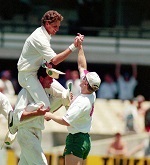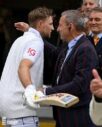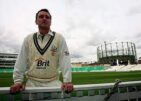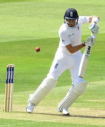Back to Back – Part 2
Gareth Bland |
No sooner had the dust settled on Australia’s home series with South Africa in early 1994 than the return series began. Just as the South Africans had made their first official trip to Australia in thirty years, so this encounter would constitute the first tour by an Australian party since Bill Lawry’s men were soundly thumped back in 1969/70.
With three Tests scheduled, along with eight one day internationals, the tour followed hard on the heels of the Australian double-headed summer which had, as always in the case of a split season, included two three- match Test series along with the three-way Benson & Hedges World Series Cup between the hosts, South Africa and New Zealand. With Antipodean hostilities completed, the South African international summer began on 19th February, when the first ODI was held at The Wanderers in Johannesburg. Three more limited overs games followed before the first Test began at The Wanderers on 4th March.
On the opening morning at Johannesburg South Africa won the toss and opted to bat. Australia blooded a new opener, Matthew Hayden, in Mark Taylor’s absence, while a seam-light bowling line up consisted of McDermott and Merv Hughes, with back up from Steve Waugh and spin from Warne and Tim May. Disappointingly, South Africa’s top five all ended up back in the hut after getting well started. Arriving at the crease with the score 116-4, Jonty Rhodes was the one to rescue the home team, enabling them to reach an ultimately unfulfilling 251.
Australia’s reply was, if anything, more disjointed with run outs accounting for Border and Mark Waugh. As with the South Africans, the entire top six got themselves well set before leaving the scene unable to push on. The Waugh brothers pitched in with 45 and 42, Border made 34, while Slater made a dashing 26. McDermott was as aggressive here as he had been in the defeat in Sydney earlier in the year, carving out 31 from just 23 balls. Ultimately, a total of 248 was some way off par for this beautiful cricket wicket.
As if to atone for their first innings profligacy, South Africa’s second innings 450 was more in keeping with earlier expectations. If Cronje had made an unofficial leadership bid for his final day cunning in the Sydney Test match, here in Johannesburg, he polished his credentials even further. A four hour 122, with 16 fours and a six, constituted the single highest contribution. Ably assisted by Hudson with 60 and Wessels and Peter Kirsten with 50 and 53 respectively, the home side eked out a 453 run lead.
A solid partnership from Boon and Slater aside, the Australians were never seriously in the hunt for the total, nor did they display the kind of nous required to save the game. Eventually dismissed for 256 the tourists were 198 short of victory. First blood then went to South Africa.
If the South Africans had looked impressive in Australia, they were formidable here. Possessing a fortitude that appeared to out-Australian the Australians, even Wisden was moved to remark “Resilience, courage and the refusal to lie down are well-known Australian traits, but the home side were superior in all aspects of the game, including discipline”
Indeed, the pressure seemed to affect the tourists so adversely that they almost lost the plot altogether. In the South African second innings, Warne, in particular, failed to hold his nerve. The leg-spinner himself has since admitted that the culture shock of South Africa, along with the perceived aggressiveness of their supporters led him to boiling point. This, he admits, is the backdrop to the abuse he showered Andrew Hudson with after bowling the opener round his legs in the South African second innings. Warne contends:
“ “I was desperate to get a wicket and with my third ball I bowled Hudson behind his legs. That set me off. I lost it completely and started telling him to `**** off. Go on, Hudson, **** off out of here!’ Hudson is a good player and a lovely bloke, a good friend of my close mate Jonty Rhodes. Andrew had done nothing to deserve that sort of abuse. Eventually Ian Healy grabbed me and tried to stop me. I look back at it now and wonder what was going on. The film of that incident is pretty awful, and the guy in the footage is not the real me.”
Warne‘s apology to Hudson was accepted, while he claims that the South Africans had a good laugh about the whole incident later on. It was a shame for Warne that match referee Donald Carr was not moved to similar acts of benevolence, the Englishman instead issuing the Victorian with a fine of 1,000 Australian Dollars.
The action then moved to Cape Town and the scene for the second Test set against the backdrop of Table Mountain. The Australians opted for balance in their attack, including McGrath at the expense of May, while Steve Waugh would add seam support. Flushed with confidence the home team batted first after winning the toss. If Andrew Hudson had been unsettled by Warne in the previous Test he did not show it here. The opener’s 102 came off just 174 balls and included 13 fours. South Africa’s 361, though solid, could have been more as it was left to Brian McMillan with 74, and Peter Kirsten with a patient 70, to shore up the innings.
Australia’s 435 in reply was built on solid contributions throughout the top order, with only Mark Waugh, dismissed for 7, missing out. Where Taylor – back in the side at Hayden’s expense – Steve Waugh and Healy had been enterprising, one great performer looked as though he was feeling the pace. Allan Border’s 45 took a painstaking four and a half hours, during which time he faced 204 balls. It was an innings of Boycott-like obduracy and endurance. David Boon, too, reigned in his attacking instincts to provide the sticking agent to the entire top order. After almost six hours Boon fell to de Villiers for 96, achingly close to the century he deserved.
Going in to bat for the second time on the fourth afternoon with a deficit of 74, South Africa cannot have envisaged that the game would be effectively over as a contest by that evening. After a shambolic collapse South Africa were 100-6 by the close of play. At 69-1 Wessels’ team did not appear in danger, and were just five runs away from erasing the first innings deficit. It was then that Steve Waugh’s medium pace and Warne’s wiles ate away at South Africa’s self-confidence, eroding it to such an extent that they were finally skittled for 164 on the fifth morning.
Requiring just 91 for victory the Australians made no mistakes this time; no calamitous, edgy negotiation of a piddling target as in Sydney two months earlier. When Mark Taylor was bowled by Donald for 14 Boon and Slater wasted no time in knocking off the runs. And so the two combatants would reconvene for their third Test of the series, and the sixth of that season’s transcontinental rubber, in Durban, a week later.
Kepler Wessels won the toss and elected to field first. Border’s team notched 269, with contributions from Boon, the Waugh brothers – 43 from Mark and 64 from Steve – and ‘keeper Healy with 55. In reply, bizarre tactics from Wessels meant that South Africa took an age to acquire their first innings 422. On an unresponsive surface South Africa ground out their runs in 205 overs. Their eventual total ensured that they would not bat again as any chance of result looked unlikely. That way it eventually remained, as Australia’s 297-4 was achieved with their great captain, Allan Border, undefeated at the end with 42. The match, like the series was drawn.
After 156 Test matches Allan Border had decided to depart the scene. He had come to his country’s need during the Packer schism which had so weekend Australia’s line-up and had been an ever-present since the Ashes summer of 1978/79. Serendipitously he had acquired the captaincy in late 1984 when Kim Hughes buckled under the strain of following the Chappell brothers. As if that was not enough he had stayed around to rebuild the Australian team when defections to Apartheid-era South Africa had decimated the Aussie game once more. Of all the things Allan Robert Border’s career is noteworthy for, surely the most fascinating is his staggering level of consistency. As Gideon Haigh has observed:
“In a boom-or-bust batting line-up, he was as reliable as a bank cheque. His average as player was 50; his average as captain 51. His average up to the age of 30 was 50.35; his average thereafter was 50.74. He was one of the top three scorers in 129 of the 265 Test innings in which he batted.”
His replacement would be a man who was more mediator than confrontationist, more Greg Chappell than Ian. Mark Taylor had made his debut in 1988/89 and the ACB had bestowed upon him the top job which was, in Kim Hughes’ assertion, second only to the Australian Prime Minister in terms of national esteem.
Back then, in early 1994, Australia were months away from monstering England once more and then, finally, from unseating the West Indians on their own patch to claim true, undoubted global supremacy in early 1995.
What, then, of South Africa? For the second time in a period of months they had shared the honours in a three Test series against the world champions-elect. At home in the ODIs they had shared the spoils, too, as the 8 game series was shared 4-4. They had been competitive and ballsy, as everyone expected they would, but even the staunchest supporters were surprised by the rapidity of their ascent. Wisden itself concluded that they had “signalled their return to the upper bracket of Test-playing countries.” South Africa’s next stop was the northern hemisphere and another truncated three match series, this time with England. There, too, they were competitive in another series not without incident, spectacle or controversy.





Leave a comment